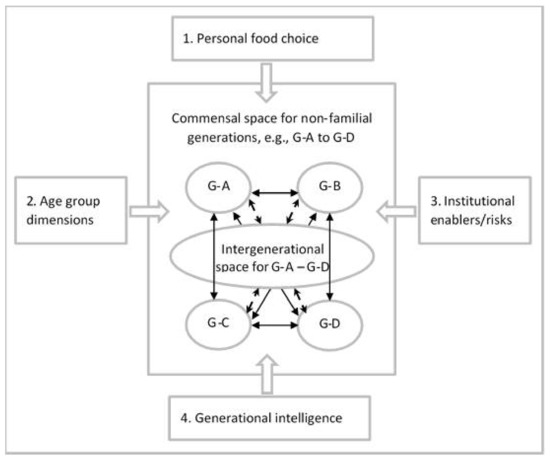Food, Nutrition and Health with Focus on Eating Together (Closed)
A project collection of International Journal of Environmental Research and Public Health (ISSN 1660-4601).
Papers displayed on this page all arise from the same project. Editorial decisions were made independently of project staff and handled by the Editor-in-Chief or qualified Editorial Board members.
Viewed by 42177Project Leader
Interests: nutrition; meal composition; meal assessment
Interests: consumption; eating behavior; meal routines; social conventions; sociology of food
Project Overview
Dear Colleagues,
The purpose of this Project Collection is to provide an interdisciplinary research overview of commensality. With this overview, we open up possibilities for new ways of understanding the art and level of importance of commensality for socialization and for health and wellbeing, thereby providing a new understanding of meal provisions, restaurant design, home design and city planning for ensuring commensality and improved health as well as quality of life in future foodscapes.
The overall aim of the Collection is to identify and collate perspectives, methods and results from studies of commensality, health and wellbeing, including quality of life, within different disciplines, thus building an interdisciplinary viewpoint for future translational research and practice.
This Project Collection arises from work within an international network of researchers engaged in inter- and multidisciplinary research on the “role of commensality in the present and the past: implications for policy and planning”. Emanating from Uppsala University, the network has grown through national and international collaboration, first nationally with Swedish institutions, the University of Agricultural Sciences and Academy of Culinary Arts and Sciences (Måltidsakademien), then internationally, with the Nordic Association for Food Studies (NAFS), University of Helsinki, University of Eastern Finland, the Institute Paul Bocuse, Lyon, France and the University of Granada, Spain.
The concepts of, and interaction between, commensality, health and wellbeing have been studied within different disciplines in the past, but each would benefit from multidimensional, interdisciplinary analyses and approaches. This, in our view, has become exceedingly topical with unprecedented changes in demographics, sociocultural diversity of dietary habits and differentiation of household compositions across countries cultures and age groups. Moreover, while generational age groups have become equal in size, increased generational interaction may be needed to negotiate individualized risks, such as dietary habits affecting our physical health and environmental sustainability. Simultaneously, however, institution-centered ecosystems (city planning) are keeping generations apart; family meals have gone through a transition in which they are more commonly consumed outside of home. The social implications of meals eaten alone seem to have shifted, with the majority of households having single occupancy in several countries. Food choice, for many, has become a privatized phenomenon with constrained possibilities to choose. We need an increased understanding of commensality, who eats with whom, where, why, how and for how long, and the way in which these meals/eating occasions affect people’s every-day life, health and wellbeing, and their quality of life. Through a developed understanding, we can identify opportunities for social and educational innovation, policy and practice, building on an understanding that stems from current as well as historical research. “Food, Nutrition and Health with Focus on Eating Together” will hopefully be of interest to all engaged in promoting community and personal health.
Prof. Dr. Agneta Yngve
Dr. Nicklas Neuman
Dr. Irja Haapala
Project Leaders
Manuscript Submission Information
Manuscripts should be submitted online at www.mdpi.com by registering and logging in to this website. Once you are registered, click here to go to the submission form. Manuscripts can be submitted until the deadline. All submissions that pass pre-check are peer-reviewed. Accepted papers will be published continuously in the journal (as soon as accepted) and will be listed together on the collection website. Research articles, review articles as well as short communications are invited. For planned papers, a title and short abstract (about 100 words) can be sent to the Editorial Office for announcement on this website.
Submitted manuscripts should not have been published previously, nor be under consideration for publication elsewhere (except conference proceedings papers). All manuscripts are thoroughly refereed through a single-blind peer-review process. A guide for authors and other relevant information for submission of manuscripts is available on the Instructions for Authors page. International Journal of Environmental Research and Public Health is an international peer-reviewed open access monthly journal published by MDPI.
Please visit the Instructions for Authors page before submitting a manuscript. The Article Processing Charge (APC) for publication in this open access journal is 2500 CHF (Swiss Francs). Submitted papers should be well formatted and use good English. Authors may use MDPI's English editing service prior to publication or during author revisions.
Keywords
- Eating together
- Commensality
- Mealtime
- Nutrition
- Food sociology
- Health
- Wellbeing
- Generations
- History
- Religion
- Culinary arts
- Education
- Dietary guidelines











